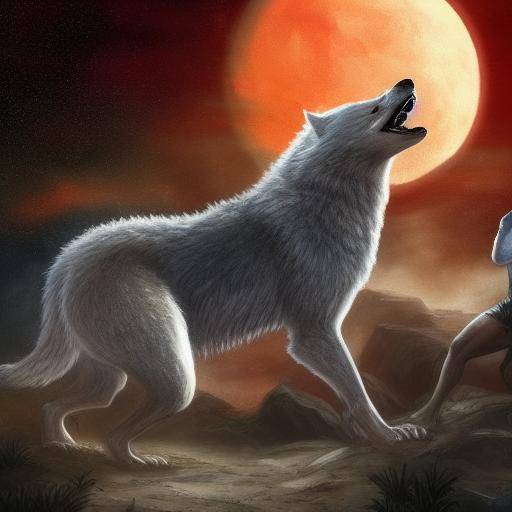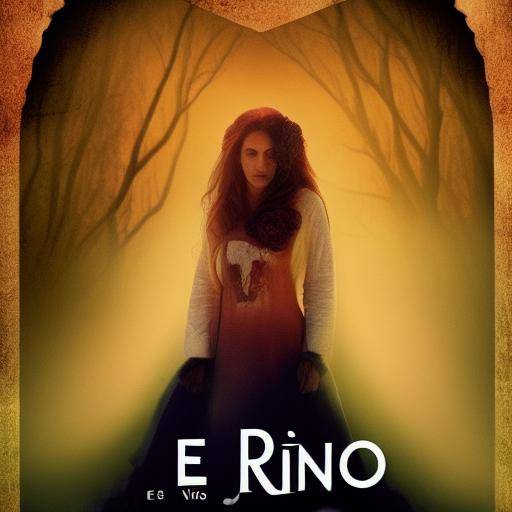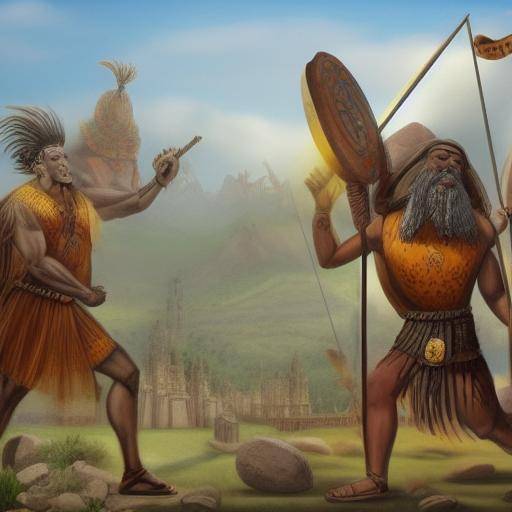
Introduction
The Fenrir wolf myth is one of the best known stories within the Nordic mythology. The figure of this monstrous wolf is intrinsically linked to the fate of the gods and at the end of the world in the Ragnarok. In this article, we will explore in detail the history of Fenrir, its relevance in the Nordic myths and the symbolism of the wolf in this fascinating tradition. We will discover the origins, their evolution throughout history and the most relevant aspects of this mythical figure. In addition, we will analyze the symbolism behind the wolf and its association with Nordic culture, as well as its influence in the contemporary world.
History and Background
The history of the wolf Fenrir dates back to the ancient traditions of Nordic mythology. In these narratives, Fenrir is described as a gigantic wolf, the son of the god Loki, representing chaos and destruction. As we explore the Nordic myths, we can recognize Fenrir as a figure that triggers crucial events in the fate of the gods. His influence on Ragnarok, the cosmic conflict that results in the end of the world, defines its importance in this mythology.
Origins and Evolution of Fenrir
The ancient Nordic accounts, dating from the Viking era, provide us with the first records of Fenrir. These narratives have endured over time, influencing literary, artistic and even contemporary folklore works. Fenrir's myth has transcended borders and remains a source of fascination for scholars and mythology enthusiasts.
Relevance in the Nordic Myths
The importance of Fenrir in the Nordic myths lies in his role as agent of destiny. His fate is interwoven with the Ragnarok, an event in which chaos and destruction are unleashed, and where Fenrir unleashes his revenge against the gods. This cosmic conflict marks the end of the world and the beginning of a new cycle in the Nordic mythology.
Symbolism of the Wolf in Nordic Culture
The wolf, represented by Fenrir, embodies key symbolic aspects within the Nordic culture. Beyond its role as antagonist in myths, the wolf symbolizes ferocity, cunning and unpredictability. These qualities have permeated the Nordic tradition, generating a rich iconography that continues to inspire various forms of artistic expression.
Deep analysis
The symbolism of the Wolf Fenrir transcends the pages of the Nordic myths, finding resonance in various cultures and times. This analysis examines how Fenrir's myth has lasted over time, influencing literature, cinema, music and other artistic expressions.
Influence in Literature
Several writers have found inspiration in Fenrir's myth, integrating his figure into stories that explore the duality between order and chaos. The Wolf Fenrir becomes a symbol of eternal struggle between opposing forces, giving readers a powerful metaphor that transcends cultural boundaries.
Representation in Popular Culture
The impact of Fenrir extends to popular culture, where its image and meaning have been assimilated in various ways. From tattoos to videogame references, their presence endures as a reminder of the complexity of the human being and his relationship with an unpredictable world.
Spirit of the Wolf: Contemporary Approaches
The essence of the wolf as a representation of instinct, freedom and ferocity has been explored in the modern psychological and philosophical sphere. The figure of Fenrir serves as a starting point to understand fundamental aspects of the human psyche, awakening debates about the intrinsic nature of the human being and its connection to the natural world.
Comprehensive review
Symbolism associated with Fenrir and the wolf in Nordic mythology has repercussions that go beyond the purely narrative. This comprehensive analysis will address the different levels of interpretation and the impact of these representations on contemporary society.
Philosophical and Psychological Outlook
The figure of the wolf, personified in Fenrir, has awakened philosophical and psychological debates on the duality of the human being and his relationship with the primordial world. From the Jewish vision of archetypes to contemporary existential reflections, the presence of the wolf in the Nordic mythology continues to inspire deep analysis of human nature.
Symbolism in Art and Culture
The symbolism of the wolf has transcended its mythological context, permeating different artistic and cultural manifestations. Through art, music and literature, the wolf has become a timeless symbol that stimulates reflection and evokes deep emotions in diverse contexts.
Relevance in the Contemporary Context
Symbolism associated with Fenrir and the wolf remains relevant today, influencing how people relate to nature, spirituality and identity. Their presence in contemporary culture is a powerful reminder of the persistence of universal themes throughout history.
Comparative analysis
The comparison between Fenrir, the Nordic myths and the symbolism of the wolf allows us to glimpse meaningful connections that reveal the depth of their influence on human culture and psyche.
Parallelisms and Divergences
When comparing the figure of Fenrir with other representations of mythical creatures in different cultures, there are interesting parallels that reveal universal themes related to fear, destruction and renewal. At the same time, differences highlight the uniqueness of Nordic mythology and its unique influence on contemporary perception.
Impact on Human Cosmovision
The presence of the wolf within the Nordic myths awakens deep reflections on the relationship between the human being and his natural environment, manifesting the interconnection between the divine and the earthly. This comparative look allows us to understand how the symbolism of the wolf has shaped human worldview throughout history.
Evolution of Language and Image
Comparative analysis reveals how the language and image associated with Fenrir and the wolf have evolved, adapting to changing contexts and needs. This phenomenon demonstrates the ability of myths to maintain their relevance by transforming and dialogue with various cultural expressions.
Practical Tips and Accessible Recommendations
If you feel inspired by wolf symbolism in Nordic mythology, here we offer practical advice to integrate your influence into your daily life. These recommendations will help you explore the meaning and relevance of the wolf in a wider sense, promoting a deeper understanding of its symbolism.
- Connection with Nature: Dedicates time to explore natural environments and reflects on the presence of the wolf in the surrounding nature. Observing its influence on ecosystems will allow you to better understand its symbolic importance.
- Literary exploration: Immerse yourself in literary works that explore wolf symbolism in diverse contexts. Reading stories, essays and novels will give you an enriching perspective on how this symbol has been reinterpreted throughout history.
- Artistic expression: Experiment with forms of artistic expression that allow you to channel the energy and meaning associated with the wolf. Painting, sculpture, music or writing are means by which you can explore and express the presence of the wolf in your life.
- Meditation and Reflection: Dedicates time to meditation and conscious reflection on the symbolism of the wolf. Explore your own instincts, emotions and connections with nature through this introspective exercise.
- Intercultural dialogue: Take the opportunity to explore the presence of the wolf in different cultures and mythologies. It establishes connections between these accounts and reflects on the universal values they share.
- Research and Continuous Learning: Expand your understanding of wolf symbolism through research and continuous learning. Explore sources of trust that address this issue from diverse perspectives, thus enriching your understanding.
Industry Perspectives and Expert Reviews
The symbolism of the wolf, rooted in the Nordic mythology, has inspired reflections and analysis by experts in various disciplines. These perspectives offer a broad and contextualized view of the impact of the wolf on human culture and its persistence on contemporaryity.
Visions of Comparative Anthropology and Mythology
Experts in comparative anthropology and mythology offer an enriching vision of the wolf's presence in different cultural traditions. Their research reveals deep connections and sheds light on the importance of the wolf as a transversal archetype.
Analysis from Psychology and Psychotherapy
Psychologists and psychotherapists have explored the symbolism of the wolf from a clinical perspective, as well as its relevance in the understanding of the collective unconscious. Their contributions deepen the understanding of the psychological dynamics associated with the symbolism of the wolf.
Explorations from Ecology and Conservation
Professionals dedicated to ecology and wildlife conservation offer a unique perspective on the presence of the wolf in the ecosystem and its importance for biodiversity. His reflections shed light on the intricate relationship between man, wolf and nature.
Case Studies and Practical Applications
The symbolism of the wolf has not only permeated culture and spirituality, but has also found practical applications in different fields. These case studies show concrete examples in which wolf symbolism has influenced and guided creative projects, initiatives and processes.
Symbol in Product Design
The symbolism of the wolf has been integrated in the design of products, from clothing to decoration articles, as a way of transmitting strength, determination and freedom. This creative approach demonstrates how the symbolic attributes of the wolf can be incorporated into everyday products to convey meaning and added value.
Applications in Gestalt Psychotherapy
Some approaches in gestalt psychotherapy have integrated wolf symbolism as a therapeutic tool, promoting deeper exploration of instincts, individuality and connection with nature. These cases reveal how wolf symbolism can enrich therapeutic practice and promote introspection.
Inspiration in Natural Space Design
The symbolism of the wolf has served as a source of inspiration in the design of natural spaces, promoting the harmonious integration of symbolic elements in natural and urban environments. These cases exemplify how the symbolism of the wolf can enrich the human experience in the built environment.
Future Trends and Predictions
The symbolism of the wolf continues to evoke fascination and arouse continuous reflections on its relevance in contemporary society. The following trends and predictions highlight the persistence of this fascination and the continuing impact of wolf symbolism on various spheres of culture and knowledge.
Renewal of Interest in Nordic Mythology and Culture
There is a growing interest in Nordic mythology and its emblematic figures, including the Fenrir wolf. This renewal of interest will be reflected in new research, creative applications and greater dissemination of wolf symbolism in cultural and educational fields.
Multidisciplinary Explorations in Animal Symbolism
The intersection between mythology, psychology, anthropology and ecology will remain a focal point for exploration, with multidisciplinary approaches that deepen the understanding of animal symbolism, including that of the wolf.
Integration in Brand and Communication Strategies
Increased integration of wolf symbolism is expected in brand and communication strategies, as organizations seek to associate their values with the strength, loyalty and adaptability represented by the wolf.
Conclusion and Frequently Asked Questions
Conclusion
The symbolism of the wolf, personified in the figure of Fenrir within the Nordic mythology, has transcended cultural and temporal borders, generating impact and fascination in various spheres. His presence continues to stimulate reflection, inspiring creativity and offering a lasting bond with nature, the human psyche and the exploration of the inner self.
Frequently asked questions
**1. What is the role of Fenrir in Nordic mythology?**Fenrir plays a crucial role in Nordic mythology as a figure that triggers Ragnarok, the cosmic conflict that results in the end of the world.
**2. How has wolf symbolism been interpreted over time?**The symbolism of the wolf has been interpreted in various ways, representing ferocity, cunning, freedom and connection with the wild.
**3. What is the relevance of the wolf in contemporary culture?**The symbolism of the wolf remains relevant in contemporary culture, influencing artistic expressions, philosophical reflections and brand strategies.
**4. What are future trends related to wolf symbolism?**Renewal of interest in Nordic mythology, multidisciplinary explorations in animal symbolism and integration into brand and communication strategies.
**5. How can I integrate wolf symbolism into my daily life?**You can integrate the symbolism of the wolf through the connection with nature, literary exploration, artistic expression, conscious meditation, intercultural dialogue and continuous learning.
**6. What is the impact of wolf symbolism on individual psychological development?**The symbolism of the wolf can have a significant impact on individual psychological development by promoting the exploration of instincts, emotions and connections with nature.
In short, the figure of the wolf Fenrir and the symbolism associated with the wolf in the Nordic mythology continue to generate fascination and offer multiple levels of interpretation. From its influence on culture and spirituality to its projection in contemporary society, the symbolism of the wolf continues to enrich the understanding of the human being and his relationship with the world around him.



